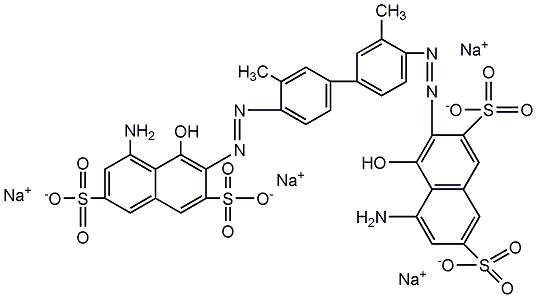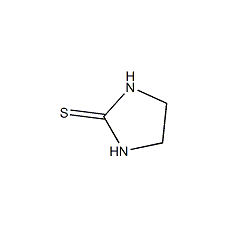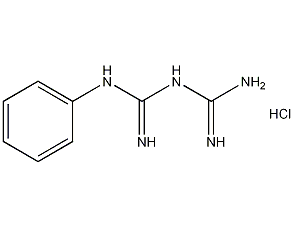
Structural formula
| Business number | 01H6 |
|---|---|
| Molecular formula | C34H24N6O14S4Na4 |
| Molecular weight | 960.81 |
| label |
Direct blue 14, trypan blue, 4-Chloro-3-iodotrifluorotoluene, 4-Chloro-3-iodobenzotrifluoro, trypan blue, Trypan Blue, 3,3′-{[3,3′-Dimethyl(1,1′-biphenyl)-4,4′-diyl]bis(azo)}bis(5-amino-4-hydroxy-2,7-naphthalenedisulfonic Acid ) Tetrasodium Salt, Diamine Blue, Niagara Blue, Direct blue 14 |
Numbering system
CAS number:72-57-1
MDL number:MFCD00003969
EINECS number:200-786-7
RTECS number:QJ6475000
BRN number:4360496
PubChem number:24858268
Physical property data
1. Character:Blue-gray powder
2. Density (g/mL,25/4℃): Unsure
3. Relative vapor density (g/mL,AIR=1): Unsure
4. Melting point (ºC):> 300
5. Boiling point (ºC,Normal pressure): Uncertain
6. Boiling point (ºC, 5.2 kPa): Unsure
7. Refractive index:Not sure
8. Flash Point (ºC): Unsure
9. Specific optical rotation (º): Unsure
10. Autoignition point or ignition temperature (ºC): Unsure
11. Vapor pressure (kPa,25 ºC): Unsure
12. Saturated vapor pressure (kPa,60 ºC): Unsure
13. Heat of combustion (KJ/mol): Unsure
14. Critical temperature (ºC): Unsure
15. Critical pressure (KPa): Unsure
16. Oil and water (octanol/Log value of water) partition coefficient: Uncertain
17. Explosion limit (%,V/V): Unsure
18. Lower explosion limit (%,V/V): Unsure
19. Solubility:Soluble in water, slightly soluble in ethanol, insoluble in other organic solvents
Toxicological data
None
Ecological data
None
Molecular structure data
None
Compute chemical data
1. Hydrogen Bonding Number of donors: 4
2. Hydrogen Bonding Number of receptors: 20
3. Rotatable Number of chemical bonds: 5
4. Interchange Number of isomers: 231
5. Topological molecules Polar surface area (TPSA):364
6. Heavy atoms Quantity: 62
7. Surface charge :0
8. Complexity :2030
9. Isotope atomic number:0
10. Determine the number of atomic stereocenters:0
11. Uncertain number of atomic stereocenters:0
12. Determine the number of stereocenters of chemical bonds:2
13. Uncertain number of chemical bond stereocenters:0
14. Number of covalent bond units: 5
Properties and stability
None
Storage method
This product should be sealed and stored in a cool, dry place.
Synthesis method
by3,3′-Sodium nitrite for dimethylbenzidine After diazotization with hydrochloric acid, in alkaline medium with HAcid coupling, followed by salting out, filtration and drying.
Purpose
Mainly used for cotton, linen, viscose and other cellulose Fiber dyeing can also be used for silk, nylon, and viscose/Dyeing of cotton blended fabrics, and can also be used for paper, leather and biological dyeing.
extended-reading:https://www.newtopchem.com/archives/1133extended-reading:https://www.bdmaee.net/pc-amine-ma-190-catalyst/extended-reading:https://www.newtopchem.com/archives/1100extended-reading:https://www.bdmaee.net/wp-content/uploads/2022/08/38-5.jpgextended-reading:https://www.bdmaee.net/polyurethane-metal-catalyst/extended-reading:https://www.bdmaee.net/wp-content/uploads/2022/08/Dibutyltin-dibenzoate-CAS1067-33-0-Dibutyltin-Dibenzoate-Solution.pdfextended-reading:https://www.cyclohexylamine.net/cas7560-83-0/extended-reading:https://www.cyclohexylamine.net/category/product/page/14/extended-reading:https://www.bdmaee.net/cas-27253-29-8/extended-reading:https://www.bdmaee.net/bis2-nn-dimethylaminoethyl-ether/












